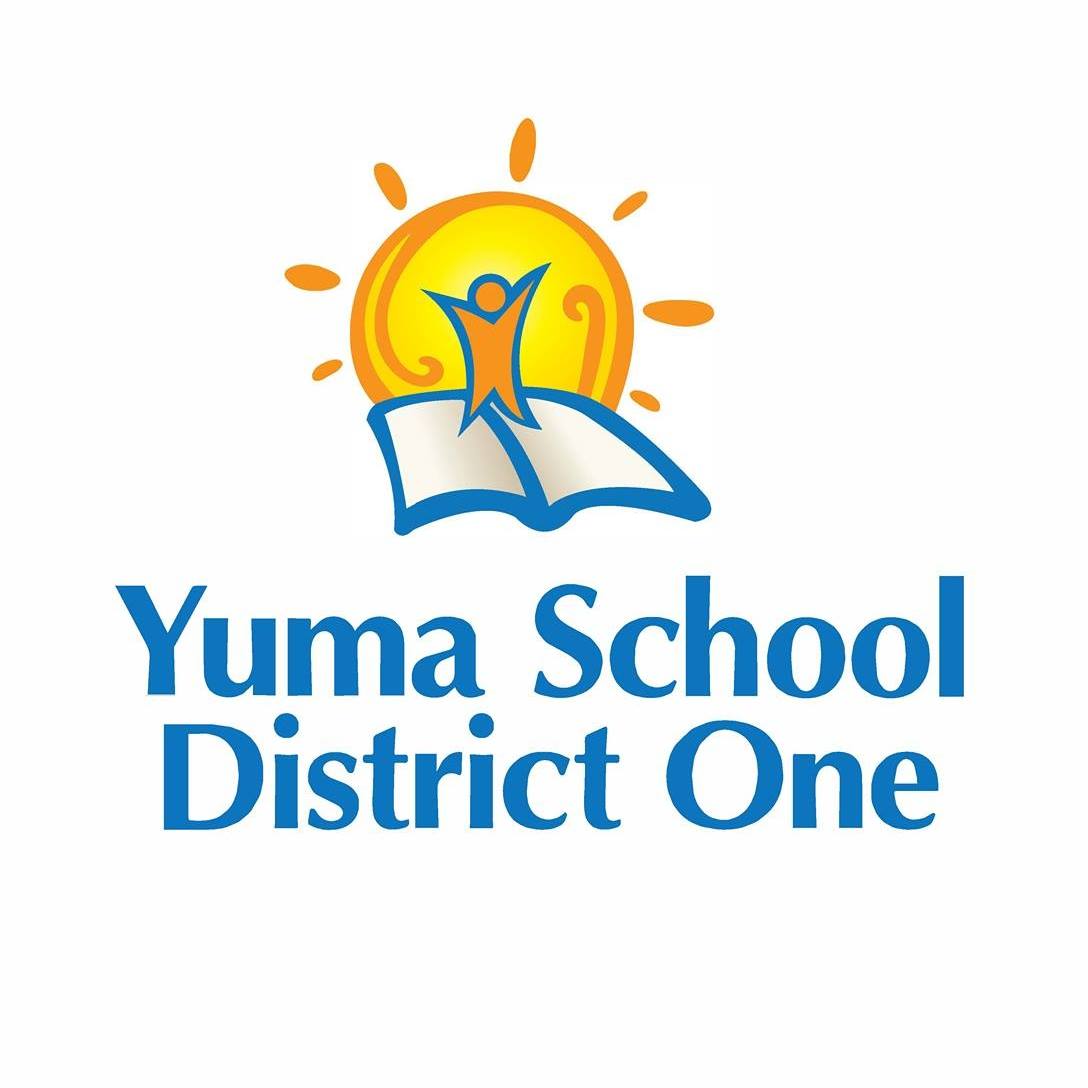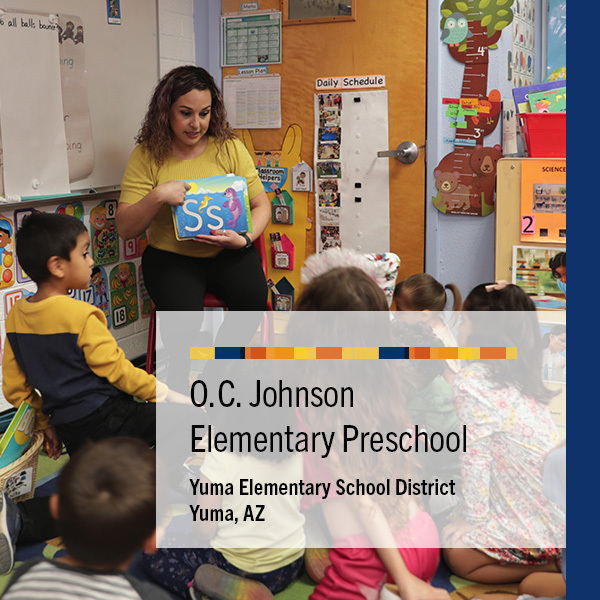

Yuma Elementary School District
Yuma, Arizona
A review of data provided to the Arizona Department of Education by more than 500 early learning programs throughout the state revealed that preschoolers at O.C. Johnson Elementary, which serves predominantly Hispanic and economically-disadvantaged students in Yuma, have consistently outperformed statewide averages on key early literacy benchmarks.
- In 2022, 93% of O.C. Johnson Elementary’s exiting preschool students met or exceeded widely-held expectations in both language and literacy, 24 percentage points above the state average for language and 18 points higher for literacy.
O.C. Johnson's commitement to student success begins with the engagement of the entire staff, which is dedicated to building literacy and community with every interaction. Members of the school community identified these factors as having fueled their strong outcomes:
- Research-based assessment tools and instructional materials.
- Coaching and professional development put into practice.
- Building a community of relationships.


TSG (Teaching Strategies GOLD®) has been the State Board of Education’s approved early childhood progress monitoring tool since 2010. This observation-based formative assessment tool captures student progress across multiple domains of learning, including language and literacy, and serves as a measure of kindergarten readiness for exiting preschoolers.
What key factors drove O.C. Johnson’s success?
O.C. Johnson Elementary is part of Yuma Elementary School District One and includes one preschool classroom. Almost half of the 60+ current preschool students are children with identified disabilities who receive preschool special education services.
Read On Arizona sat down with 11 members of the O.C. Johnson school community—including the principal, teachers, para-professionals, coaches, support staff, and a parent—to understand their approach to supporting the school readiness of its young children.

- Research-based assessment tools and instructional materials.
The preschool team at O.C. Johnson utilizes an array of proven early childhood assessment tools to continuously improve the quality of their learning environments and teacher-child interactions. They also implement a comprehensive curriculum to help children make consistent progress across the school year and support individualized learning.
Following consistent classroom routines “established on day one and followed every single day,” the team integrates play with educational activities during whole group, small group, and free play with intentionally-designed interest areas. Data and guidance from the team’s use of the ECERS (Early Childhood Environment Rating Scale®) tool ensures that classroom spaces are set up for children to want to engage in and learn, including a variety of age-appropriate toys and materials.
"Toys are tools that teachers use to teach," said Director of Preschool Erica Jimenez. When children engage with materials in the various interest areas, “that’s when teachers interact with the kids and have those conversations that support language and literacy” in ways that align with Arizona’s Early Learning Standards.
The team also uses the CLASS (Classroom Assessment Scoring System®) tool to improve the quality of teacher/child interactions, including instructional support for teachers to help children build cognitive and language skills.
O.C. Johnson Preschool’s day-to-day approach to learning is guided by the careful implementation of a comprehensive curriculum that provides children with opportunities to learn and explore. "The curriculum supports the teaching," said Jimenez. "What we are going to teach and how we are going to teach it."
The school places special emphasis on supporting the development of language and literacy skills. "If a child is playing with blocks, we can have a conversation about the study (lesson), asking questions to have them think and express themselves," said Gisela Ibarra, O.C. Johnson’s lead preschool teacher. "During art, we’re having conversations with them. During read-alouds, there’s always a lot of questioning as we read. 'What is going to happen next?' They love prediction. They feel special."
Paraprofessional Claudia Fierro highlighted even more ways the team incorporates language and literacy throughout the day. "We like to sing in the classroom, rhymes, ask questions," she said, "different ways to implement phonological awareness."
"We bring out the observations, and we make sure we're hitting all the objectives."
Observations are captured with TSG (Teaching Strategies Gold®), Arizona’s approved early childhood progress monitoring tool that is aligned with Arizona’s Early Learning Standards. Using this formative assessment tool helps the team determine if a child is below, meeting, or exceeding widely-held age-level expectations across multiple domains of learning.
With all teachers and paraprofessionals aware of the learning objectives in each developmental area, as well as an understanding of each child’s progress, the team can scaffold and modify classroom activities in real-time to help individual students with specific skills.
“We really do believe in knowing each individual child in and out,” said Rachel Butcher, a special education resource teacher, “and then finding materials that motivate that student.”
They meet regularly to review all their observations and lesson plans. Looking at the data as a team helps everyone know what children need to work on or when they can move on to something new. “We bring out the observations,” explained Ms. Ibarra, “and we make sure we’re hitting all the objectives. If we’re missing story re-telling, (for example), we’ll work together on it.”
Literacy coach Danielle McElroy has seen how well this approach works in Ms. Ibarra’s classroom. “They use the tools — ECCERS, CLASS, the curriculum — and adapt and scaffold to fit their learners’ needs. It’s amazing."

- Coaching and professional development put into practice.
Yuma District One has successfully braided funding streams to provide targeted literacy-based instructional coaching to its schools, including a subgrant award from Arizona’s federal Comprehensive State Literacy Development (CLSD) grant program administered by the Arizona Department of Education.
District Literacy Coach Danielle McElroy observes the preschool classroom for areas of strength and opportunities for improvement in teacher/child interactions and ways to get students actively involved. She has also provided several professional learning opportunities focused on language and literacy.
Because of its growth mindset and understanding of the value of every teacher/child interaction, school leadership has found ways to include its paraprofessionals in these trainings, as well. This strategy of investing in the professional development of all staff has been a key lever to improving its preschool programming and student outcomes.
"After every PD they’re in, the team is applying the strategies the next day."
Eugenia Smith, Yuma School District’s preschool coordinator, has seen the professional development being put into practice during her classroom observations at O.C. Johnson. “They’re running with it,” said Smith. “Gisela is running with it, and the paras (paraprofessionals) are running with it. And it trickles down to the kids. The children are so engaged, in the circle times, stories, music and movement. It’s just fantastic to see how much (the professional development) is being used. It’s wonderful.”
Preschool Director Erica Jimenez has seen the staff’s enthusiasm for professional learning, too. “After every PD they’re in,” she said, “the team is applying the strategies the next day.”
O.C. Johnson also benefits from coaching via its participation in Quality First, Arizona’s quality improvement and rating system. The preschool has earned a 5-star rating from Quality First, far exceeding quality standards.
Gloria Renteria, the school’s Quality First coach, observes the classroom, goes over ECCERS and CLASS assessment data with the team, and helps them set goals for improvement. “My role, and the strategy that I know has worked, is observation and feedback,” said Renteria. “I ask reflective questions” to engage classroom teachers to think about their practices and identify areas to further develop. Then she offers her expertise. It’s a coaching model that has worked over several years at O.C. Johnson.
“When I come back, I can see that they’ve implemented those recommendations, and I see the impact,” said Renteria. “And then we move on to another challenge!”

- Building a community of relationships.
O.C. Johnson views early education as a “community responsibility” that goes beyond the preschool classroom team. Every educator and staff member at the school approaches every interaction with a young child as an opportunity to build a positive relationship and deliver a caring, language-rich interaction. These relationships grow over the course of the year, as do the children.
“From the time the preschoolers walk in to when they leave (at the end of the year), what a huge difference!” said Luz Orta, O.C. Johnson’s cafeteria manager. “They bloom, and it’s beautiful!”
The preschool team is especially adept at connecting with their young students. “The relationships they build with the kids are amazing,” said Principal Angela Logan. “And it’s quick,” even among students new to the school. “The kids feel loved, and they respond to the team.”
"They are in a loving environment with loving relationships. Which is the perfect classroom to thrive."
Young children need to feel safe and secure in their environment for learning to take place. Working with their Quality First coach, Gloria Renteria, and with guidelines from the CLASS tool, the O.C. Johnson preschool team has created an environment conducive to learning. “CLASS starts with emotional support,” said Renteria. “The kids have a predictable schedule. They have nutritious meals. They are in a loving environment with loving relationships. Which is the perfect classroom to thrive.”
The impact of all these intentional efforts is made clear by the preschool’s impressive benchmark assessment results and how its students successfully transition to kindergarten.
“They skip into kindergarten,” said Principal Logan. “Their communication, they’re ready and willing to talk with any staff member. Their comfort level with school is huge.” Entering kindergarteners who haven’t attended preschool sometimes “struggle for weeks until we get them comfortable. I wish we had more preschool classrooms!”
Aneth Adame has seen her daughter thrive in Ms. Ibarra’s classroom. She was initially concerned about her daughter’s speech and how she would interact with other students, but now sees “so much growth. She has blossomed into a leader,” said Aneth. She has also seen improvement in her daughter’s dexterity with scissors, which she realizes makes her “little hands ready for writing.”
While admitting that she doesn’t have a deep understanding of the school’s approach to assessment, curriculum, and professional development, Aneth is grateful for the results. “I just love that it’s working,” she said. “I feel confident that my daughter is getting ready for kinder.”

Read On Arizona thanks all the O.C. Johnson Elementary Preschool interviewees:
Angela Logan, Principal
Erica Jimenez, Preschool Director
Gisela Ibarra, Preschool Teacher
Claudia Fierro, Preschool Paraprofessional
Kassandra Martinez, Preschool Paraprofessional
Rachel Butcher, Resource Teacher (Special Education)
Luz Orta, Cafeteria Manager
Danielle McElroy, Literacy Coach
Gloria Renteria, Quality First Coach
Eugenia Smith, Preschool Coordinator
Aneth Adame, Parent